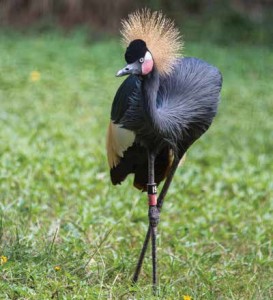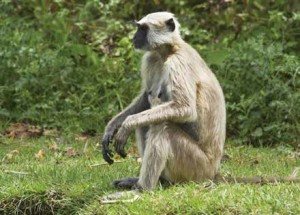Cooperative Conservation
by Tim L. Tetzlaff
Naples Zoo Director of Conservation
 As you stroll through the gardens at Naples Zoo, I’m willing to guess your first thought isn’t how all these animals got here. And that’s good. Better to stand in awe at the wonders of the natural world while gazing into a tiger’s eyes. Yet that visceral experience wouldn’t be possible without the cooperation of an enormous number of people across the nation’s accredited zoos, conservation organizations, and wildlife agencies. As you see what’s new at the Zoo below, reflect on the number of different parties involved. Collectively, these represent thousands of keepers, scientists, veterinarians, researchers, rangers, and conservationists who do everything from daily care to assessing the risks these animals face in the wild. Passionate people who dedicate their lives to the animals we all love – very literally with their blood, sweat, and tears. And they wouldn’t have it any other way. I hope you enjoy reading what we’ve been up to lately.
As you stroll through the gardens at Naples Zoo, I’m willing to guess your first thought isn’t how all these animals got here. And that’s good. Better to stand in awe at the wonders of the natural world while gazing into a tiger’s eyes. Yet that visceral experience wouldn’t be possible without the cooperation of an enormous number of people across the nation’s accredited zoos, conservation organizations, and wildlife agencies. As you see what’s new at the Zoo below, reflect on the number of different parties involved. Collectively, these represent thousands of keepers, scientists, veterinarians, researchers, rangers, and conservationists who do everything from daily care to assessing the risks these animals face in the wild. Passionate people who dedicate their lives to the animals we all love – very literally with their blood, sweat, and tears. And they wouldn’t have it any other way. I hope you enjoy reading what we’ve been up to lately.
LANGUR AND SIAMANG ENJOYING ISLAND LIFE TOGETHER
Just recently, we welcomed a female Hanuman langur from the Chattanooga Zoo. Named after Hanuman, the Hindu monkey god, this Asian primate can often be seen around temples in India. Like our female siamang, she was temporarily housed by herself. As neither was recommended for breeding, we thought these two ladies might enjoy each other’s company. After the langur cleared the standard quarantine, our keepers moved our siamang from the island into an area where zoo staff could readily monitor the introduction. Everything went as hoped for and you can now see them on the Primate Expedition Cruise as they hang out together on their own private island.
MALAGASY MOVES
 As part of the Species Survival Plan® (SSP) for fosas, our older female fosa received a breeding recommendation which requires a move to another accredited zoo. During her time in Naples, she gave birth to four fosa cubs. These fascinating carnivores are vulnerable to extinction on the island of Madagascar. Taking her place are two red-ruffed lemurs that are now listed as critically endangered. Their range is limited to the Masoala peninsula in northeast Madagascar – a region that experienced devastating illegal logging following a political coup in 2009. Our male arrived from the Bronx Zoo and the female came from Gladys Porter Zoo in Texas. Per the SSP, this city boy and country girl are recommended for breeding. And don’t worry fosa fans, you can still see two of the cubs that were born here right next to the new lemurs.
As part of the Species Survival Plan® (SSP) for fosas, our older female fosa received a breeding recommendation which requires a move to another accredited zoo. During her time in Naples, she gave birth to four fosa cubs. These fascinating carnivores are vulnerable to extinction on the island of Madagascar. Taking her place are two red-ruffed lemurs that are now listed as critically endangered. Their range is limited to the Masoala peninsula in northeast Madagascar – a region that experienced devastating illegal logging following a political coup in 2009. Our male arrived from the Bronx Zoo and the female came from Gladys Porter Zoo in Texas. Per the SSP, this city boy and country girl are recommended for breeding. And don’t worry fosa fans, you can still see two of the cubs that were born here right next to the new lemurs.
ORPHAN PANTHER KITTEN GETS SECOND CHANCE
This past summer, we opened up an exhibit for Uno, the Florida panther that survived two shotgun blasts but was left blinded. As part of this new exhibit, the Zoo also created an area behind the scenes where Florida Fish and Wildlife Conservation Commission biologists could bring panthers that needed short term care. Just a few months later, our facility received its first feline visitor: a kitten orphaned after her mother was killed in a car accident. This adorable kitten is a powerful reminder to slow down in the posted panther zones. Please remind your friends that slowing down from 60 mph to 45 mph for a three-mile-long panther zone only adds one minute of driving time to the trip, but could give panthers a lifetime.
WATER-LOVING CRANES AND ANTELOPE
 Last year, we welcomed a pair of black crowned cranes from San Diego Safari Park and Disney’s Animal Kingdom. These elegant birds are found in the marshes and grasslands below the Sahel in Africa. Carrying the wetland theme through, they are joined this year by a sitatunga that arrived from the North Carolina Zoo. This shaggy coated antelope can live a semi-aquatic lifestyle. Notably, its hooves are splayed out and are longer than antelope twice their weight allowing them to walk in wet environments without sinking. They will even run into deep water to avoid predators – going so far as to submerge with only their nostrils above water! Naples Zoo is cooperating with the larger breeding program in response to a call for help from the Ungulate Taxon Advisory Group for this species. While males are solitary in the wild, we hope to welcome a female in the future.
Last year, we welcomed a pair of black crowned cranes from San Diego Safari Park and Disney’s Animal Kingdom. These elegant birds are found in the marshes and grasslands below the Sahel in Africa. Carrying the wetland theme through, they are joined this year by a sitatunga that arrived from the North Carolina Zoo. This shaggy coated antelope can live a semi-aquatic lifestyle. Notably, its hooves are splayed out and are longer than antelope twice their weight allowing them to walk in wet environments without sinking. They will even run into deep water to avoid predators – going so far as to submerge with only their nostrils above water! Naples Zoo is cooperating with the larger breeding program in response to a call for help from the Ungulate Taxon Advisory Group for this species. While males are solitary in the wild, we hope to welcome a female in the future.
CHEETAHS, GAZELLES, AND GIRAFFE
Late last year, Naples Zoo got word from the Cheetah SSP that we’ll be welcoming two 9-year-old female cheetahs. They will be arriving from White Oak Conservation Center. You should be able to see them in the early part of the year. And if White Oak sounds familiar, it’s because our giraffe named Jigsaw moved there last year for breeding. That’s also where we will be sending one of our critically endangered slender-horned gazelles for a recommended breeding. Finally, Niklas, another of our giraffe, will be moving to Memphis Zoo as part of another SSP recommended transfer for breeding. Given the 40 percent decline in giraffe populations in the last 15 years, breeding programs like this are crucial as a hedge against extinction.
NAPLES ZOO SOCIETY LAUNCHED
Over the past year, we have been crafting a program to recognize our most dedicated donors. The result is the Naples Zoo Society. Donors that give a gift of $1,000 or more are invited to join the Society. Society members become partners in present and future successes like all those above and so much more. If you’d like to help ongoing conservation and education efforts, call 239.262.5409 ext. 144 or visit www.napleszoo.org/society.
Far from the simple menageries of past, today’s nationally accredited zoos are centers of learning and natural crossroads for biologists, educators, environmental scientists, and researchers – as well as for students, conservationists, and all animal lovers. Naples Zoo at Caribbean Gardens is a trusted, private 501(c)(3) nonprofit serving wildlife and families here and around the world. More information at www.napleszoo.org.


Leave a Reply
Want to join the discussion?Feel free to contribute!